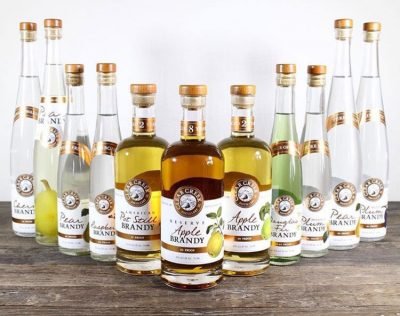
Alien Life Forms in Clear Creek Distillery Bottles Identified!
Yet another article from The New York Times on Portland, or to be more specific, Clear Creek Distillery. They have some really nice pictures of pears that have been grown in the bottles, but most interesting is the attitude of Clear Creek’s Stephen McCarthy.
While the tall, bearded Mr. McCarthy is ordinarily mild-mannered and affable, his tone hardens when the subject turns to cocktails.
“We don’t consciously sell to that market,” he said as we walked among the four small copper-topped pot stills in his bright new distillery. “We get these bright-eyed and bushy-tailed bartenders who’ve invented something, and that’s great. Maybe I’m dead wrong, but I’ve sought out the fruit and gone to great lengths to insure their purity.”
Interesting article; you can read it by clicking here
Exactly how expensive is the “World’s Most Expensive Dessert”?
According to Forbes Traveler, the price is $14,500, but you get to keep the accompanying 80-carat gem that is part of the presentation. Next time one of our readers is at The Fortress at Sri Lanka, please try the Aquamarine and send me a review. I promise to publish it.
The next one on the list is a much more affordable Brownie Extraordinaire with Saint Louis from Brûlée: The Dessert Experience in Atlantic City. It “comes with a Saint Louis crystal atomizer, a $750 keepsake filled with a shot of rare 1996 Quinta do Noval Nacional port wine to be sprayed into the mouth between each bite of hazelnut-coated brownie.” I wonder if you can get it to go?If y’all would like to take up a collection to give it a try, I’d be happy to give it my best shot. Seems to me you’d be getting a bargain. [Forbes links are no longer valid]
Sir Loins says
Yikes! This oyster warning comes just a couple of nights after downing a dozen of Washington’s finest. Seems like the PacNW gets some sort of shellfish advisory warning annually, whatever the cause behind the warning may be.
Hell, it may be even more often than that; didn’t we already have a red tide warning for all shellfish regarding the region’s coastal dead zone earlier this year?
sidemeat says
How about some generic warning that swallowing a dozen live animals
might involve some risk?
Nikos says
Taco Bell?!The Emperor has no clothes? Does that mean I shouldn’t feel guilty about my occasional Burgerville trips?
Food Dude says
Nikos, obviously you missed reading my Ode to Mr. Bell, or even my April Fools review of Taco Bell.
littleredbikecafe says
Animal style, animal style, animal style…
Nikos says
It is common wisdom that one should not eat oysters in months with the letter r in them. It is sage medical advice however to not eat oysters in months that contain a vowel!
Your review of Taco Bell is a hoot! Besides, there’s nothing like driving with one hand, soft shell tacos on the other, contents spilling all over the seat, almost running over a bunch of pedestrians, priceless !
LadyConcierge says
Uh, Nikos, I thing you mean one should not eat oysters in months without the letter ‘r’.
I, however, will eat ’em anyway if they come from the colder water regions.
Sir Loins says
Nikos, I believe LadyC is correct.
However, I’ve only heard this rule applied to east coast oysters. Where I grew up, the relatively warm waters of the Apalachicola Bay provided our oysters. In the hot summer months, you couldn’t buy an oyster even if you wanted to take the risk, because no one carried ’em.
But in Oregon, oysters are available for purchase and served year-round in restaurants. Like the Lady said, cold waters on this side of the country.
Still, I’d be curious to know if anyone thinks the rule of “eat no oysters in months without the letter ‘r’ ” also applies in the Pacific Northwest.
themick says
The reason for the “rule” (I believe) is two fold…..1) Most oysters spawn during the summer (If you see an opaque milkiness in the oyster that means it is spawning) but there are many strains of oysters called “summer oysters” that spawn at other times of the year meaning that specific oysters have a “season”. 2) Red tide. Red tides are created by low tides in warm weather (summer) that create a bacteria which affects the oyster.
Nikos says
Correct LadyC and Sir Loins, my lapse. Themick may have the right answer, summer oysters may have higher um…sex content (yikes)
The vowel rule is probably the safest, although to deny oneself the sensual pleasure of a good fresh oyster to eliminate the possibility of a food borne illness is, I admit, a bit extreme.
vespabelle says
My six year old consumed quite a few barbequed (not quite raw but not up to 145 deg either) oysters last week in the San Juans. They were from our friend’s beach on Samish Island. No signs of illness thankfully!